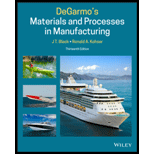
Concept explainers
Briefly describe the evolution of forming equipment from ancient to modern.
The evolution of forming equipments from ancient to modern.
Explanation of Solution
Forming is the metal-working method of producing metal parts and objects. The Ancient forged equipments have a strong arm and hammers, and the metal is heated in large hot fire pits for a long time.
The modern machinery for forging has now changed into high powered hammers and mechanical presses. The accuracy of modern machinery is increased and also manufacturing of metals is more durable in less time. Manual presses is converted to machine processes during the industrial revolution. The machinery now becomes bigger, faster, and more powerful, now computer-controlled automated operations are performed by the machines.
Want to see more full solutions like this?
Chapter 18 Solutions
Degarmo's Materials And Processes In Manufacturing
- Explanation of the Forging process with drawing.arrow_forwardThe quantity of work that can be done in the die may be used as a defining feature of forging processes. Please identify the following three broad classes that this sorting generates.arrow_forwardFib the time period, if pure rolling is the conditionarrow_forward
- Forging processes may be characterized by die work limitation. This categorization yields three basic types.arrow_forwardMajor metal forming processes include ______ a rolling to reduce the thickness for making metal sheets, strips, bars, structure shapes, and pipes. b forging to produce parts with higher strength c extrusion to produce hollow shapes, and shapes with muliple longitudinal cavities. d all of the above.arrow_forward21) a). Briefly explain the drop forging process with a neat diagram.arrow_forward
- some examples about deep drwing?arrow_forwardIdentify the type of forming process in which the material is required to pass repeatedly through dies of different size. a. Drop forging process b. Wire drawing process c. Rolling process d. Extrusion procesarrow_forwardA blanking operation is to be performed on 2.0 mm thick cold-rolled steel (half hard). The part is circular with diameter 75.0 mm. Calculate the appropriate punch and die sizes for this operation. (Take Allowance coefficient A. = 0.075)arrow_forward
 Welding: Principles and Applications (MindTap Cou...Mechanical EngineeringISBN:9781305494695Author:Larry JeffusPublisher:Cengage Learning
Welding: Principles and Applications (MindTap Cou...Mechanical EngineeringISBN:9781305494695Author:Larry JeffusPublisher:Cengage Learning
